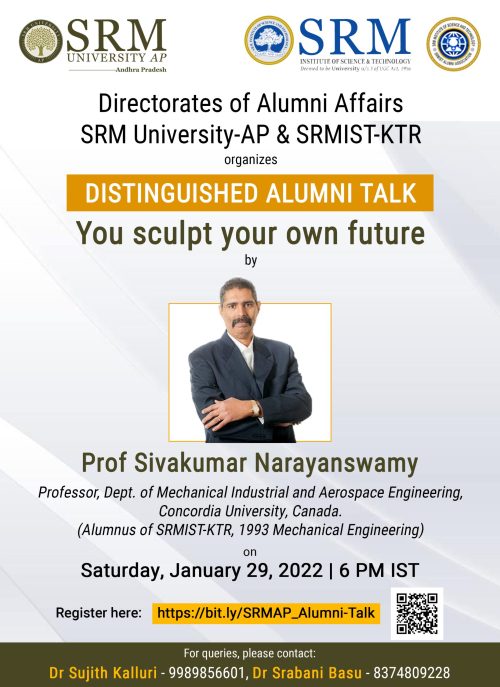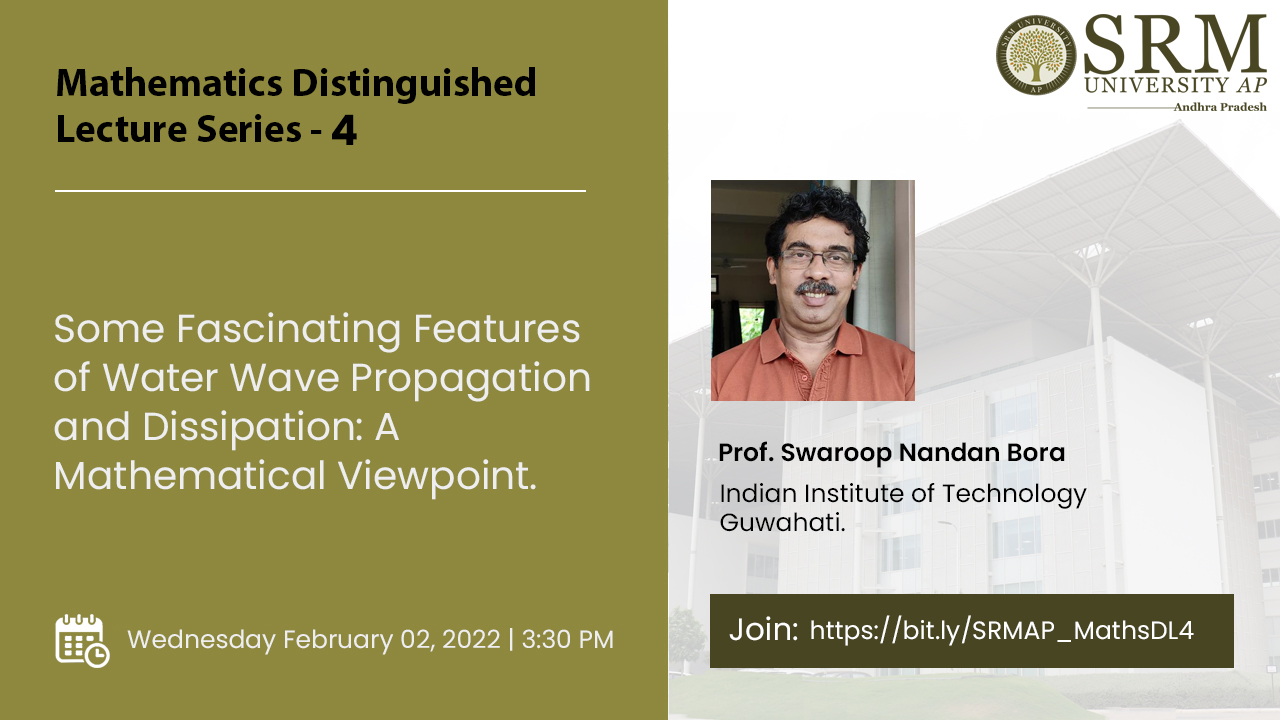Dr Jagadish influenced the young brigade of SRMAP on the making of self-reliant India
“Using Light to Sense and Interface humans could be the 4th Industrial Revolution,” said Dr Chennupati Jagadish, a distinguished professor in Physics in the Research School of Physics and Engineering at the Australian National University in his talk on “Semiconductor Nanostructures for Optoelectronics Applications” in the fourteenth edition of the University Distinguished Lecture Series conducted by SRM University-AP, Andhra Pradesh on January 22, 2022.
The event was inaugurated by Prof V S Rao, esteemed Vice-Chancellor (SRM University-AP). The revered Pro-Vice-Chancellor (SRM University-AP), Prof D Narayana Rao, powerfully emphasised on event’s motives, vision, and outreach, “Universities are creators of new knowledge, innovative ideas, and providers of talented and skilled manpower to the world.”
Dr Jagadish was honoured as Champion of the Order of Australia for his eminent contributions to Physics and Engineering at the Australia Day Honours 2016. He has acquired the IEEE Pioneer Award in Nanotechnology (2015), the Walter Boas Medal from the Australian Institute of Physics (2013) and the Thomas Ranken Lyle Medal from the Australian Academy of Science (2019).
Dr Jagadish has led the Semiconductor Optoelectronics and Nanotechnology Group as its head since its establishment in 1990 by him. He believes that digital and biological technology will merge in the fourth industrial revolution. As 90% of our information is received by light, the Optical and photo-electronics based trillion-dollar industries will double in their value by 2030. He addressed the growing interest in research and analysis on nanowires in the field of electronics and communications, which could have far-reaching benefits. He noted that the development of nanowires could address a wide range of challenges in science and technology.
The developing research in Augmented Reality, Wearable Optical Sensors, Holographic Displays etc. and the people working on it as the students and staff at SRM University-AP stand to enhance the market and build upon the vision of a self-reliant India, according to Dr Jagadish.
His talk elaborated on the ongoing research, challenges and possibilities of development in this sector, and he concluded on the optimistic note that more and more researchers would come up with new ideas or world-changing solutions.
The event series was attended by over 2300 members from varying walks of the science field from IITs, NITs, IISERs, Universities and Institutions, CSIR, DST, DBT, DRDO, DAE, ISRO, NARL, MoES and several others from different parts of the country.
- Published in News
Sculpt Your Own Future with Professor Sivakumar Narayanswamy
 We can never predict what our lives and careers hold. But we are each dealt with our own share of materials to work with and then entrusted with tools that we learn to use.
We can never predict what our lives and careers hold. But we are each dealt with our own share of materials to work with and then entrusted with tools that we learn to use.
Every student of SRM University-AP is a gem that is chosen after careful testing and consideration. This University makes every tool available to the young and energetic minds to test their skills. However, it is not the tools in hands that make an artist but how the tools are used.
We encourage our students to quest with unquenchable curiosity, to think proactively and to design innovatively. To the right aspirations and ambitious efforts, the sky is the limit.
To this end, we bring to you our Distinguished Alumni, in association with SRMIST-KTR, Dr Sivakumar Narayanswamy, Professor at the Department of Mechanical Engineering, Concordia University, Montreal, Canada.
Date: January 29, 2022
Time: 6.00 pm IST
- Published in Alumni Relations, Events
Some Fascinating Features of Water Wave Propagation and Dissipation: A Mathematical Viewpoint
 The Department of Mathematics is going to host the fourth instalment of the Distinguished Lecture on February 2, 2022, at 3:30 PM with Prof Swaroop Nandan Bora from the Indian Institute of Technology Guwahati as the keynote speaker. Dr Bora will be speaking on “Some Fascinating Features of Water Wave Propagation and Dissipation: A Mathematical Viewpoint”.
The Department of Mathematics is going to host the fourth instalment of the Distinguished Lecture on February 2, 2022, at 3:30 PM with Prof Swaroop Nandan Bora from the Indian Institute of Technology Guwahati as the keynote speaker. Dr Bora will be speaking on “Some Fascinating Features of Water Wave Propagation and Dissipation: A Mathematical Viewpoint”.
Prof Swaroop Nandan Bora received his PhD in Mathematics from Dalhousie University in Halifax, Canada. He joined the Department of Mathematics, Indian Institute of Technology Guwahati in 1999. He is also the youngest son of the renowned novelist and Padma Shri recipient Lakshmi Nandan Bora.
Prof Bora’s research interest includes Water Wave Mechanics, River Mechanics, Sloshing Dynamics, Flow through Porous Media, Differential Equation, Fractional Differential Equation. He has been elected to don the cap of the President of the Indian Society of Theoretical and Applied Mechanics (ISTAM).
Some Fascinating Features of Water Wave Propagation and Dissipation: A Mathematical Viewpoint:
Long since oceans have been serving mankind in various ways and of course, at the same time, the waves have also shown their fury at times by claiming lives and creating huge destruction. In order to understand the oceans and the strength they display through waves, it becomes very pertinent to study ocean waves, their behaviour and effects with respect to wave propagation, scattering, damping, trapping etc., which influence a number of issues in connection with marine structures and coastal regions. The comfortable situation to work with ocean waves is by considering simple conditions thereby neglecting many important aspects such as the porosity of the structures that are installed in the ocean for various activities, the porous and elastic effects of the sea-bed and also the unevenness of the sea-bed. However, the real situation demands that some or all of these be taken into account while modelling a problem so that the problem is formulated for a more realistic scenario.
In order to reduce the wave impact on marine structures (i.e., to dissipate the wave effects), it is essential that the structures (such as cylinders, barriers, caissons) possess in them the ability to reflect the wave and help in attenuating the wave energy. This brings into fore the utility of porous structures which can be used as breakwaters in the coastal and offshore regions for various applications. Further, it is practically impossible to find sea-beds that are flat and do not possess any porosity or elasticity. In other words, a more realistic formulation can be carried out by considering structures possessing porosity, and sea-beds being uneven and possessing porosity and/or elasticity.
The objective of this talk is to discuss the scattering of water waves by various types of porous structures placed on flat or uneven sea-bed which may possess porosity and/or elasticity. The study focuses on how reflection varies when different important parameters are changed. The observations made from this study will allow one to design structures that will be effective enough to reduce wave impact on the structures. In this talk, some results will be displayed which portray the physical scenario. An attempt will be made to present some practical problems which take into account a number of important properties and parameters so that the results become practical to be followed by relevant people for various activities with regard to protecting certain regions and structures from harsh ocean wave action. It will mainly emphasize the significant role that porosity and elasticity play with regard to ocean wave propagation and various related issues. The emphasis will be on the modelling of the problems which will establish the essence of mathematics.
A brief and friendly introduction to water wave propagation will precede the main components of the talk to give some general idea to the audience.
Join the exciting Lecture on February 2, 2022, at 3:30 PM with Prof Swaroop Nandan Bora.
- Published in Events, Math Events

